This Special Release presents data on volume and value of production of fisheries in the province of Cavite for the first quarter of 2024. Figures are based on the preliminary results of the tabulated data from the Quarterly Fisheries Survey, Fisheries Statistics Division (FSD).
Volume of Fisheries Production
The total volume of fisheries production in CALABARZON dropped by 31.10 percent from the first quarter of 2023-2024. The Province of Cavite decreased by 13.63 percent, from the 5,346.25 metric tons reported in same quarter of 2023 to 4,617.62 metric tons in the same period of 2024. Among the five provinces, Quezon has the most significant decrease at 65.33 percent accounting for the largest portion of the regional decline. Rizal was the only province that showed an increase, with a 17.41 percent growth in production. (Refer to Table 1 for details.)
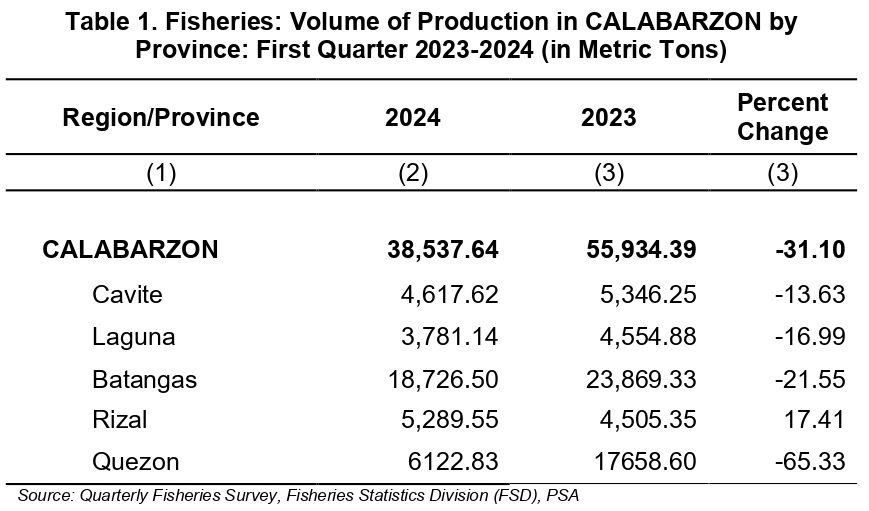
11.98 percent in the beginning period of 2024, although there’s a decrease, its share remains relatively stable. (Refer to Figure 1 for details.)
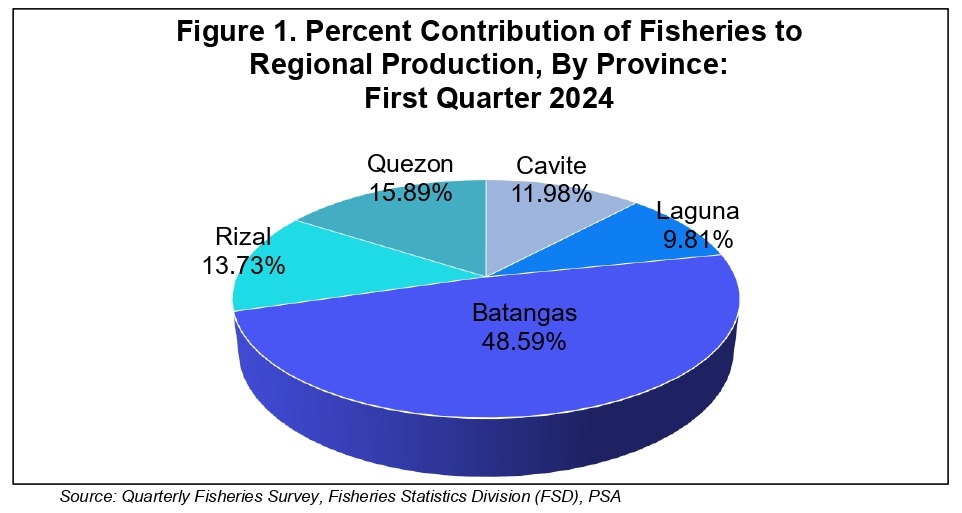
Volume of Fisheries Production by Sector
CALABARZON’s fisheries production for the first quarter of 2023-2024 showed an overall declining trend across most sectors at 31.10 percent. The province of Cavite had a total of 4,617.62 metric tons of fisheries production in the first quarter of 2024 with a decrease of 13.63 percent from 5,346.25 metric tons in the same period of 2023.
Moreover, the four sectors in the province decreased from the same period last year. Inland fisheries output had the highest decrease of 58.08 percent while commercial fisheries slightly decreased by 1.43 percent from 2,353.17 metric tons in 2023 to 2,319.49 metric tons in 2024. (Refer to Table 2 for details.)

In the first quarter of 2025, Cavite's fisheries production was predominantly driven by the commercial fisheries sector, which contributed 50.23 percent to the total output. The municipal fisheries sector followed with a 40.11 percent share. Meanwhile, aquaculture and inland fisheries had minimal contributions, accounting for 9.66 percent and 0.11 percent, respectively. (Refer to Figure 2 for details).
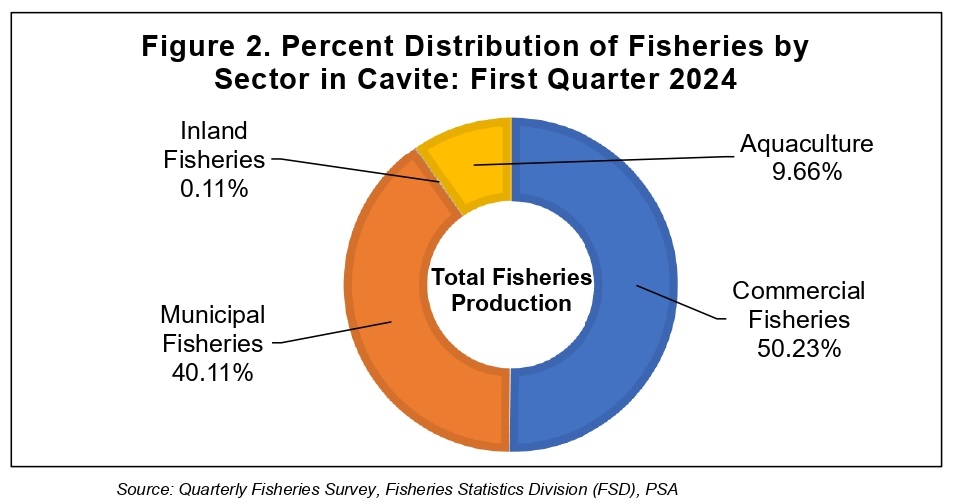
Value of Production by Sector in Cavite
Cavite province experienced a moderate decline of 8.35 percent in total fishery production value from 932.70 million pesos in 2023 to 854.82 million pesos in 2024, compared to a much steeper 41.56 percent drop across the whole CALABARZON region. Inland fisheries had the only growth in the region, up by 5.96 percent, contrary to the value in the province of Cavite, which had the biggest drop in percentage, 46.24 percent. (Refer to Table 3 for details.)

Volume of Aquaculture Production
Aquaculture production in CALABARZON displayed a significantly growth in most ecosystems. Brackishwater fishpond recorded the highest growth in the region and in the province of Cavite, by 403.15 percent and 252.03 percent, respectively. Brackishwater pen had no recorded production for the entire region. However, freshwater fishponds increased by 65.98 percent in the region, while the reported production in Cavite went down by 45.45 percent, from 5.94 metric tons in 2023 to 3.24 metric tons in 2024. Marine cage had an increase of 289.73 percent in the region even though Cavite had reported no production in the same period. The production of mussels in Cavite reflected in the whole region, which declined by 45.22 percent, dropping from 746.89 metric tons in the first quarter of 2023 to 409.17 metric tons in the same period of 2024. (Refer to Table 4 for details.)
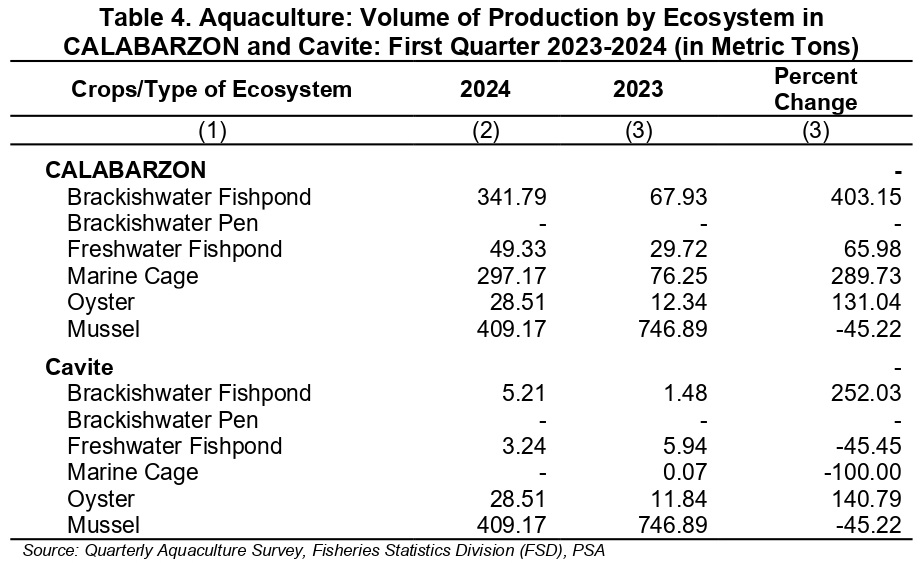
Value of Aquaculture Production
Despite the growth in the volume of aquaculture production, both CALABARZON and Cavite experienced a decline in total production value for the first quarter of 2023 and 2024, with 31.84 percent and 30.66 percent, respectively.
Brackishwater fishpond production value reported 441.26 percent increase in the province of Cavite, from 269.71 thousand pesos in the same period of 2023 to 1.46 million pesos in the first quarter of 2024. Freshwater fishpond dropped to 29.66 percent in value while marine cages by 100 percent decreased with no recorded production for the first quarter of 2024. Additionally, the production value of mussels decreased to 38.33 percent from 28.93 million pesos in 2023 to 17.84 million pesos on the same period of 2024. (Refer to Table 5 for details.)
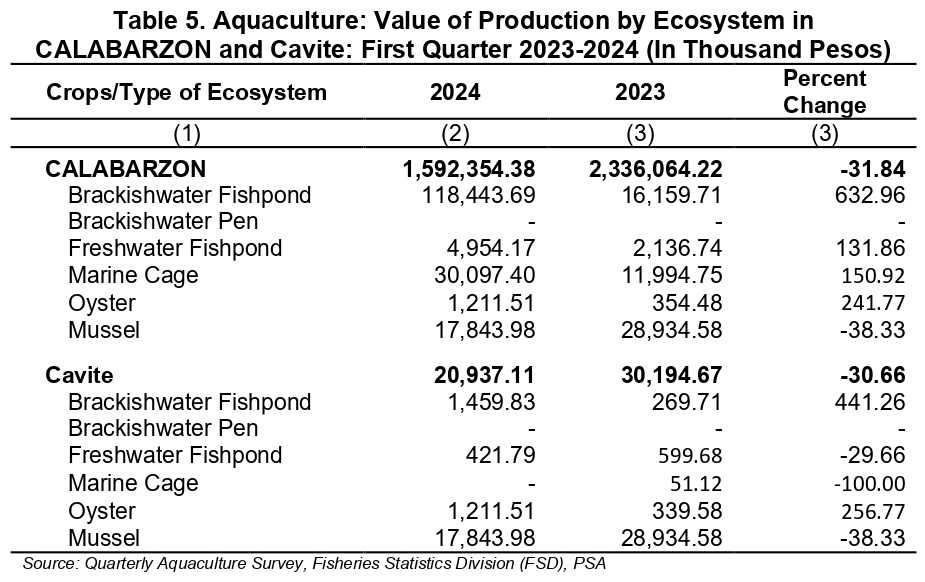
TECHNICAL NOTES
The Fisheries Situation Report is a quarterly publication by the Philippine Statistics Authority (PSA) that provides data on the volume and value of fisheries production. This report is based on four key surveys conducted by the PSA:
Quarterly Commercial Fisheries Survey (QCFS)
Quarterly Municipal Fisheries Survey (QMFS)
Quarterly Inland Fisheries Survey (QIFS), and
Quarterly Aquaculture Survey (QAqS)
These surveys are conducted quarterly, with reference periods as follows:
• First Quarter: January to March
• Second Quarter: April to June
• Third Quarter: July to September
• Fourth Quarter: October to December
Data collection method varies by survey:
• QCFS and QMFS: Data are gathered from sample fish landing centers on a monthly basis.
• QIFS: Data are collected from sample households engaged in inland fishing quarterly.
• QAqS: Data are obtained from sample aquafarms involved in aquaculture activities quarterly.
Definition of Terms
Fisheries – refer to all activities relating to the act or business of fishing, culturing, preserving, processing, marketing, deceloping, conserving, and managing aquatic resources and the fishery areas including the privilege to fish or take aquatic resources thereof (Republic Act No. 8550 otherwise known as “The Philippine Fisheries Code of 1998”).
Volume of Production – is the total weight in metric tons of the species from commercial, municipal, aquaculture and inland fisheries.
Value of Production – is the total price in thousand pesos of the species from commercial, municipal, aquaculture, and inland fisheries.
Quarterly Commercial Fisheries Survey – is a survey on volume and price of fish unloaded at sample commercial fish landing centers by fishing boats with gross tonnage of more than three (3) tons. Data on commercial fisheries are collected in fish landing centers where fishermen unload and trade their catch.
Quarterly Municipal Fisheries Survey – is a survey on volume and price of fish unloaded in municipal traditional fish landing centers by fishing boat with gross tonnage three (3) tons and less.
Quarterly Inland Fisheries Survey – is a survey on volume and price of fish, by species caught by the households engaged in inland fishing.
Quarterly Aquaculture Survey – is a quarterly survey that generates aquaculture production and area estimates. It asks for the actual level of production, area harvested and price for each species during the reference quarter of the current and previous year from the sample operators in the top producing municipalities.
Types of Ecosystems refers to the type of water environment where the various species were cultured.
Brackishwater Fishpond – a land-based type of aquafarm that utilizes a brackish water, mixture of seawater and freshwater for fish farming or aquaculture.
Brackishwater Pen – is an artificial enclosure constructed within a brackishwater for culturing fish and fishery/aquatic resources made up of bamboo poles closely arranged in an enclosure with wooden materials, screen, or nylon netting to prevent escape of fish.
Freshwater Fishpond – a land-based type of aquafarm; a pure fresh water where fish and other aquatic products are cultured, raised of cultivated under controlled conditions.
Marine Cage – a stationary or floating fish enclosure made of synthetic net wire/bamboo screen or other materials with or without cover with all sides either tied to poles staked to the water bottom or with anchored floats for aquaculture purposes.
Oyster – an aquafarm involved in the cultivation of oyster in shallow brackish or marine areas by any method for production purposes.
Mussel – an aquafarm involved in the cultivation of mussel in shallow brackish or marine areas by any method for production purposes.
For more details, please visit www.psa.gov.ph
